

How to become smarter by doing less in the information age. Common: Believing that focusing on detail is the only and best path to success.
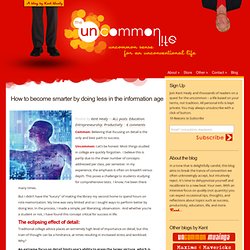
Uncommon: Let’s be honest: Most things studied in college are quickly forgotten. I believe this is partly due to the sheer number of concepts addressed per class, per semester. In my experience, the emphasis is often on breadth versus depth. Hacking Knowledge: 77 Ways to Learn Faster, Deeper, and Better. If someone granted you one wish, what do you imagine you would want out of life that you haven’t gotten yet?

For many people, it would be self-improvement and knowledge. Newcounter knowledge is the backbone of society’s progress. Great thinkers such as Leonardo da Vinci, Thomas Edison, Benjamin Franklin, Albert Einstein, and others’ quests for knowledge have led society to many of the marvels we enjoy today. Back to Basics: Perfect Your Note-Taking Techniques. WannaLearn.com. How to use binaural beats for brainwave entrainment.
Squareeater uses a combination of binaural audio and stroboscopic visual effects in an attempt to achieve brainwave entrainment in the user.
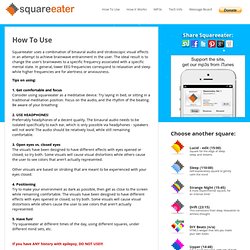
The ideal result is to change the user's brainwaves to a specific frequency associated with a specific mental state. In general, lower EEG frequencies correspond to relaxation and sleep while higher frequencies are for alertness or anxiousness. Tips on using: 1. Get comfortable and focus Consider using squareeater as a meditative device. Dreyfus model of skill acquisition. In the fields of education and operations research, the Dreyfus model of skill acquisition is a model of how students acquire skills through formal instruction and practicing.

Brothers Stuart and Hubert Dreyfus proposed the model in 1980 in an influential, 18-page report on their research at the University of California, Berkeley, Operations Research Center for the United States Air Force Office of Scientific Research.[1] The original model proposes that a student passes through five distinct stages: novice, competence, proficiency, expertise, and mastery. The original five-stage model[edit] Michael Eraut summarized the five stages of increasing skill as follows:[2] Instead the original Dreyfus model is based on four binary qualities: Recollection (non-situational or situational)Recognition (decomposed or holistic)Decision (analytical or intuitive)Awareness (monitoring or absorbed) Four stages of competence. In psychology, the four stages of competence, or the "conscious competence" learning model, relates to the psychological states involved in the process of progressing from incompetence to competence in a skill.
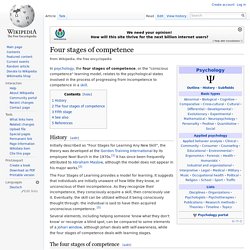
History[edit] The Four Stages of Learning provides a model for learning. It suggests that individuals are initially unaware of how little they know, or unconscious of their incompetence. As they recognize their incompetence, they consciously acquire a skill, then consciously use it. Hacking Knowledge: 77 Ways to Learn Faster, Deeper, and Better. 25 Useful Brainstorming Techniques. By Celes on Feb 9, 2009 | ShareThis Email This Post Caught with a problem you cannot solve?

Need new ideas and solutions? The process of brainstorming requires you to think out of the box that is keeping you in the problem. The idea for this post was triggered by a question from a reader, who asked me on my thoughts of the best brainstorming methods to achieve the best results. Mind Mapping, Concept Mapping, Argument Mapping: What are the differences and Do they Matter? (Martin Davies)
Concept mapping, mind mapping and argumentmapping: what are the differences and do they matter?
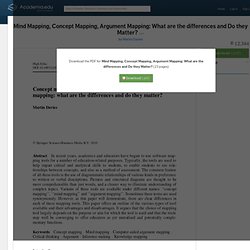
Martin Davies Springer Science+Business Media B.V. 2010 Abstract In recent years, academics and educators have begun to use software map-ping tools for a number of education-related purposes. Lucid dream. A lucid dream is any dream in which one is aware that one is dreaming.
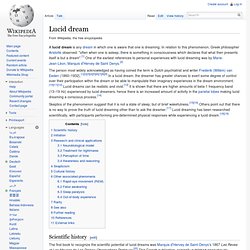
In relation to this phenomenon, Greek philosopher Aristotle observed: "often when one is asleep, there is something in consciousness which declares that what then presents itself is but a dream".[1] One of the earliest references to personal experiences with lucid dreaming was by Marie-Jean-Léon, Marquis d'Hervey de Saint Denys.[2] Skeptics of the phenomenon suggest that it is not a state of sleep, but of brief wakefulness.[15][16] Others point out that there is no way to prove the truth of lucid dreaming other than to ask the dreamer.[17] Lucid dreaming has been researched scientifically, with participants performing pre-determined physical responses while experiencing a lucid dream.[18][19] Scientific history[edit] Philosopher Norman Malcolm's 1959 text Dreaming[22] had argued against the possibility of checking the accuracy of dream reports.
Hearne's results were not widely distributed. Initiation[edit] REM sleep. eBooks.com The World's Leading Source of eBooks. Your Free Ebook Search Engine! MASONIC EDUCATION BLOG. Here are the newest pages which we have recently put up onto the site, along with the dates they were created.
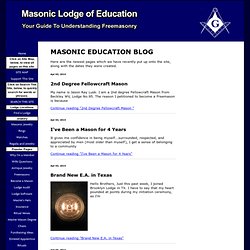
Apr 03, 2014. Brainwave entrainment. Brainwave Entrainment is any practice that aims to cause brainwave frequencies to fall into step with a periodic stimulus having a frequency corresponding to the intended brain-state (for example, to induce sleep), usually attempted with the use of specialized software.
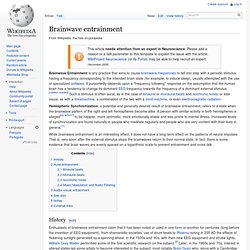
Autogenic Training. CG Jung Page. Mind Tools.